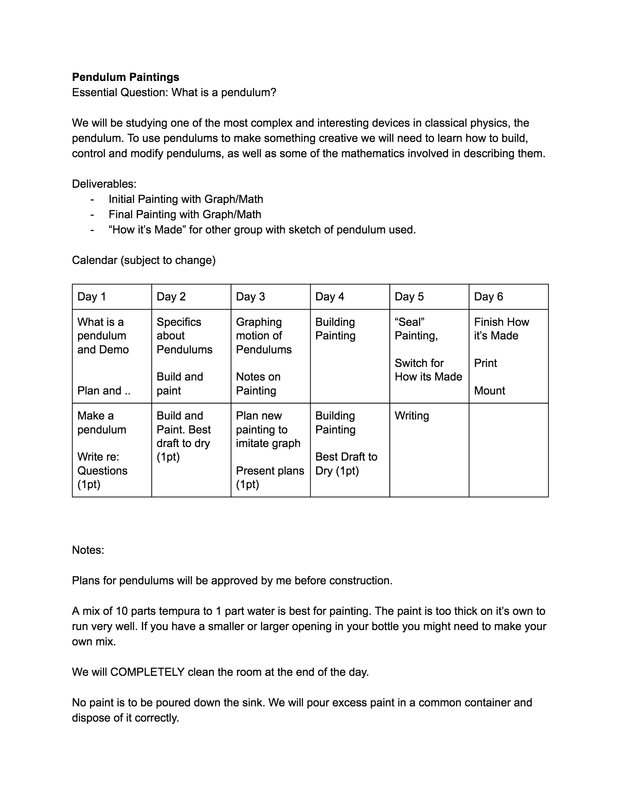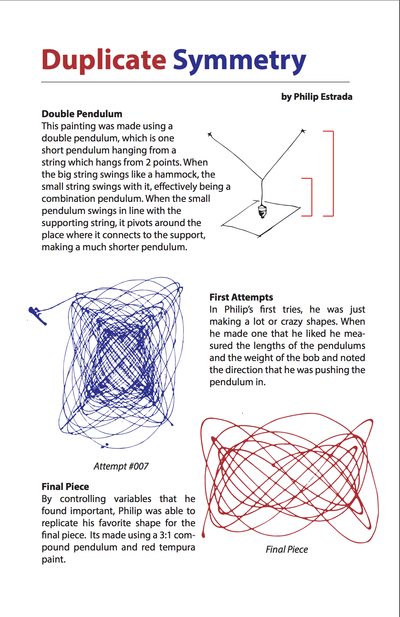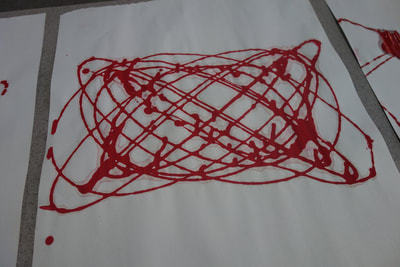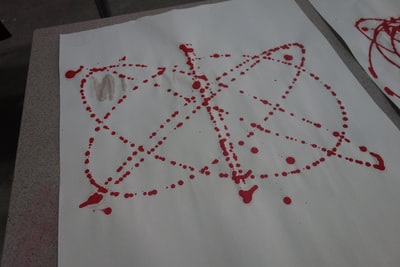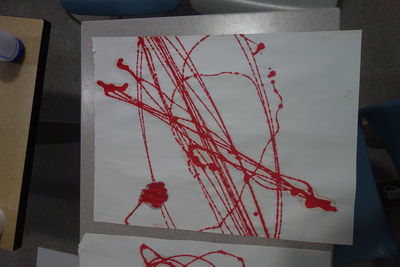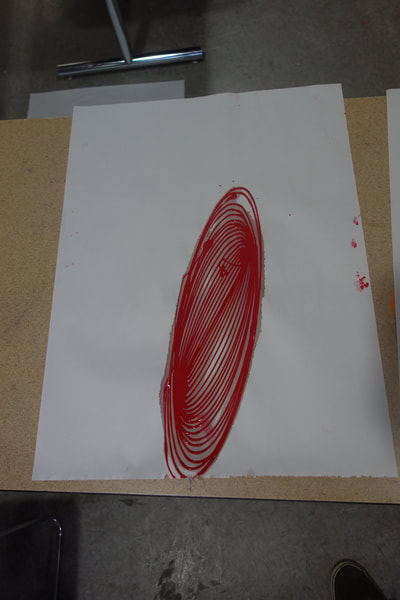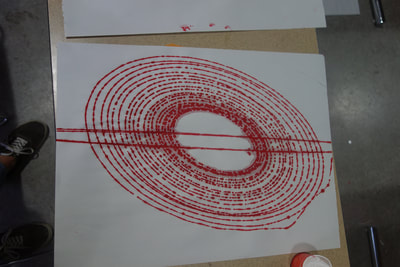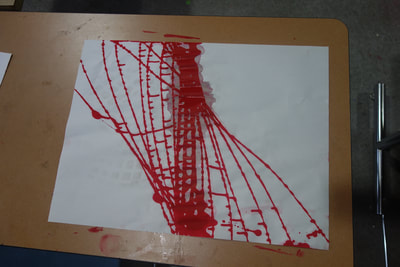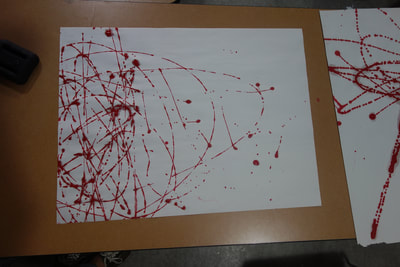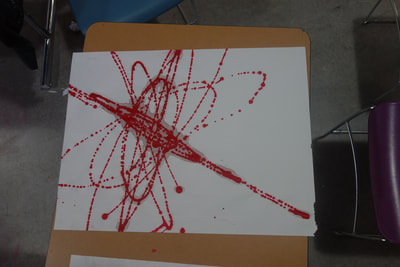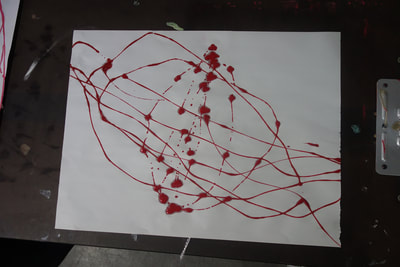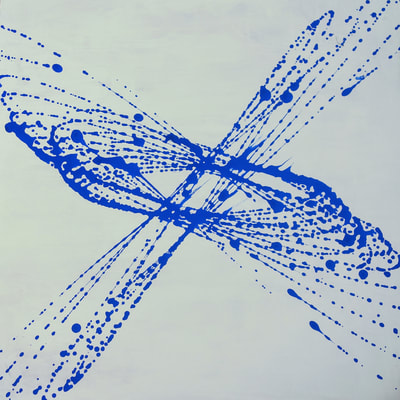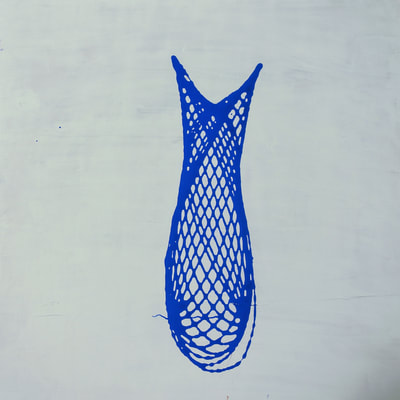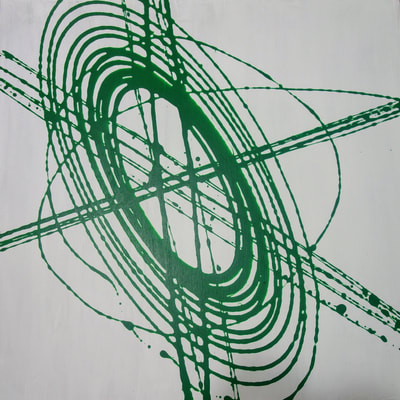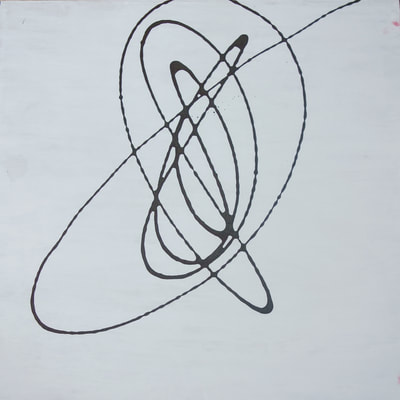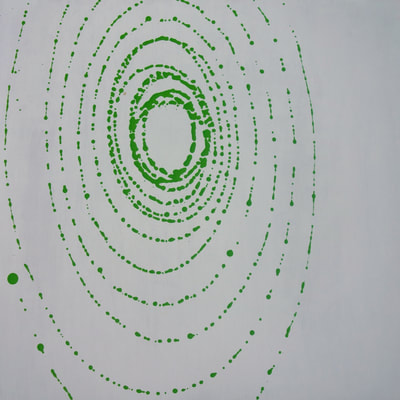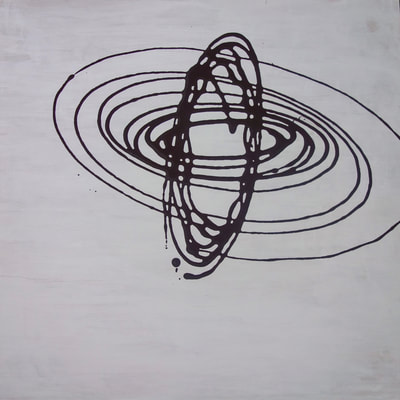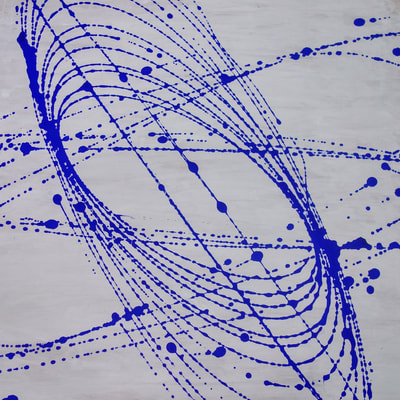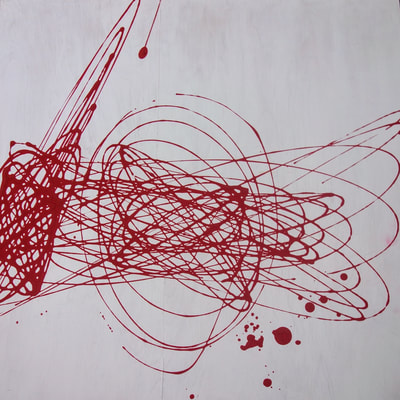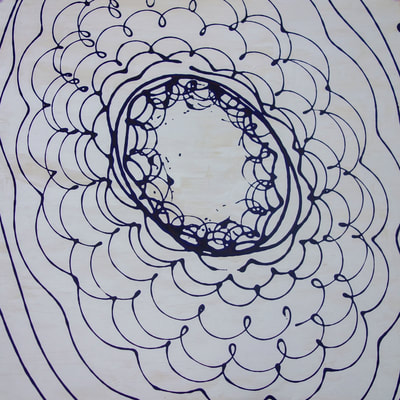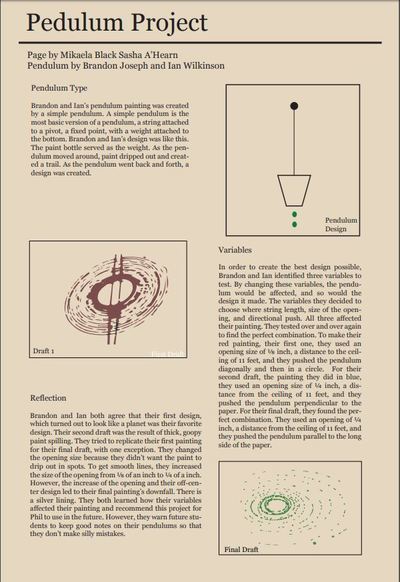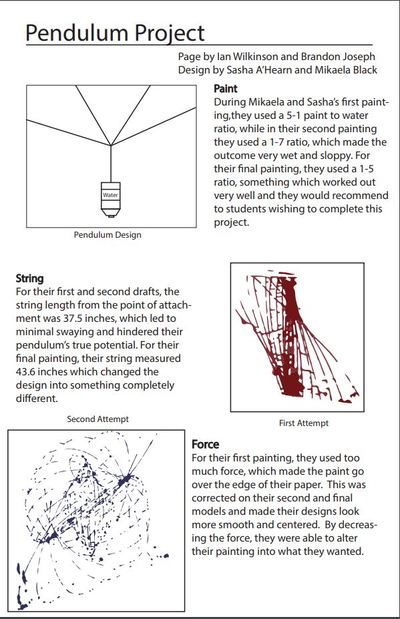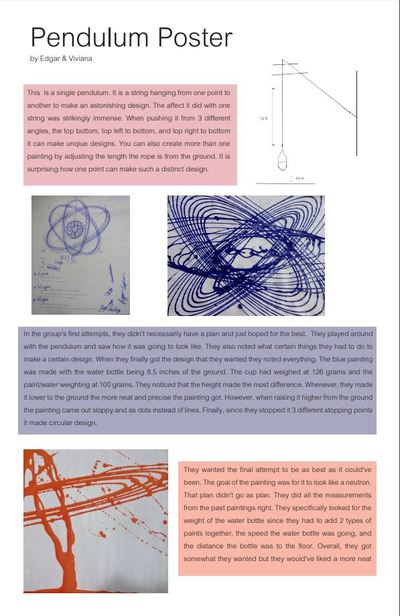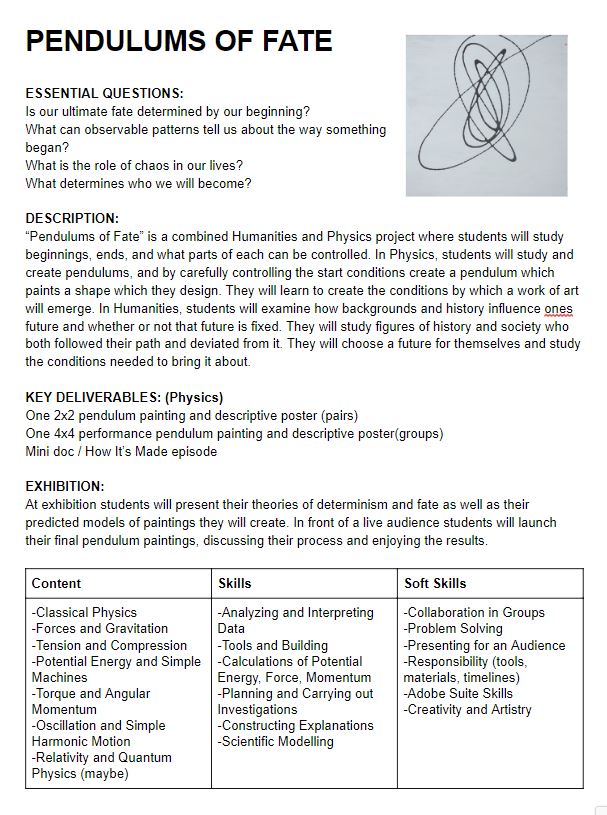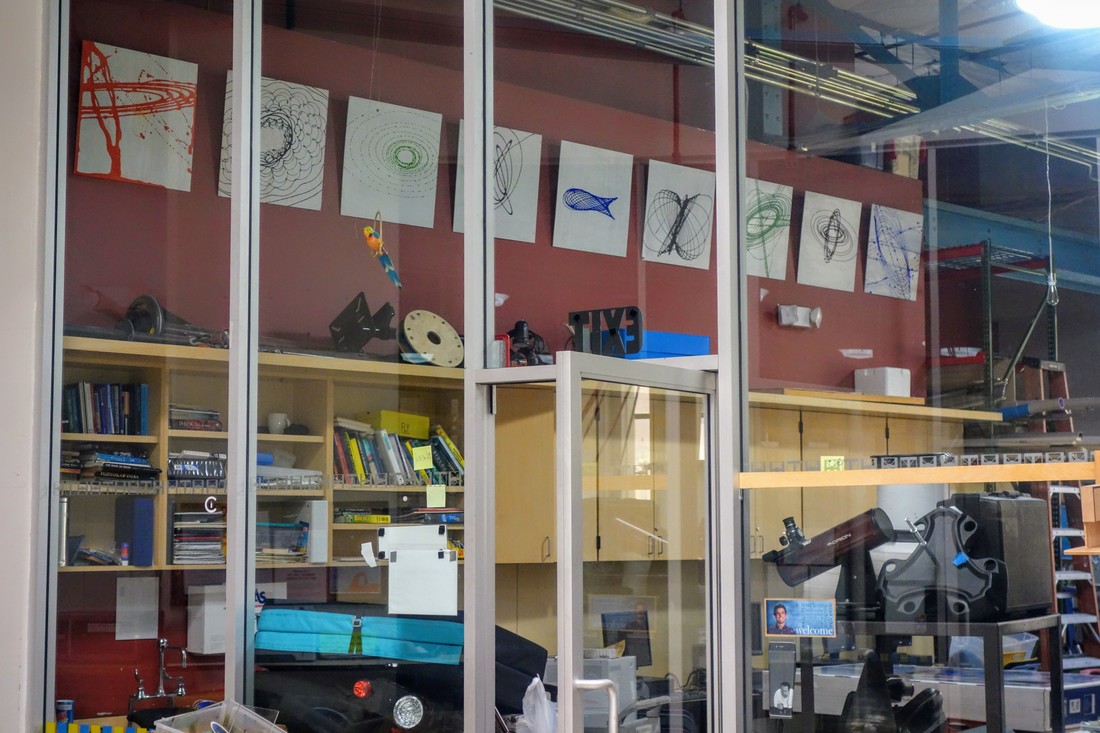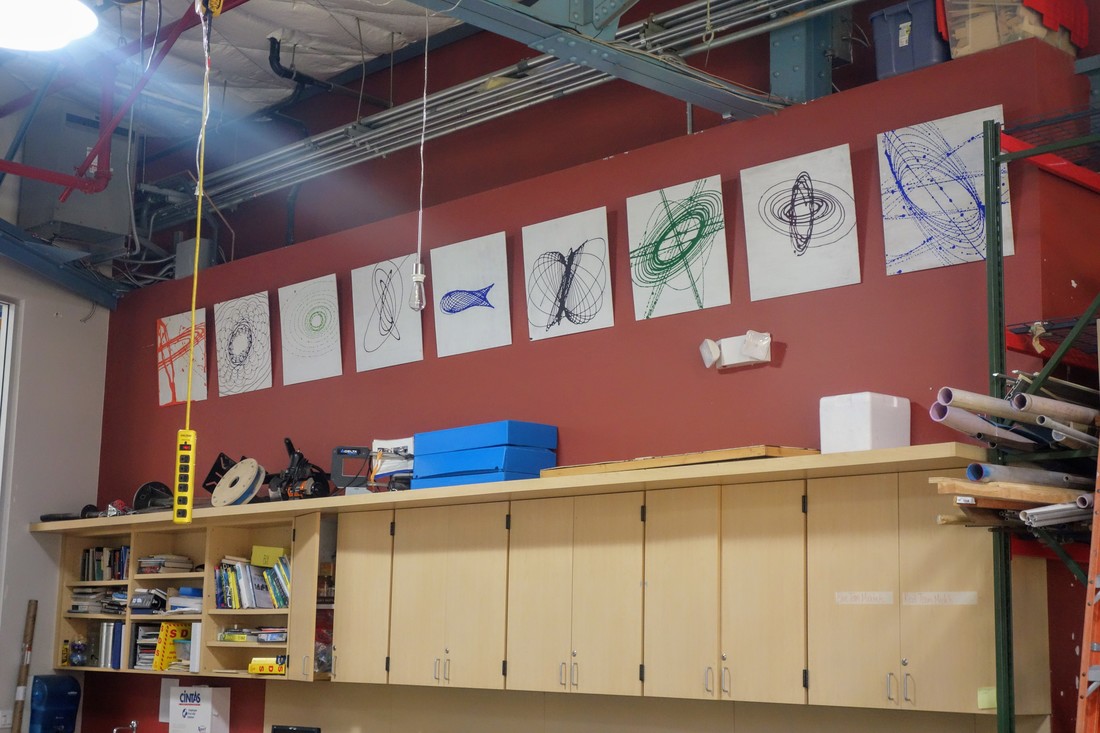-
Projects
- Talkin Trash
- Something New
- Nothing New
- Shift
- Ritual
- Colors and Shapes
- Tensegrity
- Lakeview Cut
- Second Nature
- It Gets Funkier
- Making Space
- Rotational Volumes
- Changed By Chairs
- Gearboxes
- Pendulums
- Microscopic Images
- Inspraytion
- 60 Word Short Stories
- PBL Illustrations
- Foundations Podcast
- Inclusive Strategies Podcast
- Helpful Links
- Blog
- About
This semester we finished the project really early (by design). There is a space of about 3 weeks that I'm filling up by having the class prototype project ideas for me. One of them is about painting with pendulums. I'm running a miniature version of the project and getting feedback from the class on what works and doesn't work.
I'm using this page to update on progress as I go because I want to record what how a project changes and morphs before it's finally launched. Summaries of each day to be found below.
I'm using this page to update on progress as I go because I want to record what how a project changes and morphs before it's finally launched. Summaries of each day to be found below.
Planning
|
While browsing videos on YouTube looking for project ideas I came across this Bruce Yeany video where he makes Lissajous patterns with sand pendulums. I got excited to try and make my own. Instead of using sand, I used paint to record my shapes and had a lot of fun doing it. I thought that it would be fun to make these paintings with a class and study the physics that dictate why they move the way that they do.
|
I learned a lot by trying everything myself first. I learned that the paint that I was using needed to be thinned out before it would flow nicely, and that having the bottle too high from the page didn't make great lines, and that I needed a lot of space to make my pendulum.
|
Once I was able to reliably make a painting that I was happy with, I prepared a wooden canvas and used a more interesting color of paint. I set up the pendulum according to my notes and made my final version. Then I wrote up a short document describing how I made the painting and what it was. These became the final products for the project.
|
To the left you can see the planning document that I made for the project prototype. There are six days, which I would expand to 3 or 4 weeks in a future project.
Changes: I removed the section about graphing. For my particular pendulum I was able to sort of figure out a graph that described what was happening but when I saw the variety of pendulums that the class was making I knew that I wouldn't be able to support them all. Because I still wanted to think about the pendulums mathematically I shifted the focus from graphing to tracking variables. Once we finish I'll discuss whether or not it was successful. I also removed the scoring system that I had intended to prototype because I didn't want to bog down the project at this time. Another time will come to try out new grading techniques. |
Deliverables
Students will make:
- Initial draft painting with notes on how it will be improved // This was not something that I originally planned but once the focus changed from graphing to variables I realized that it would be useful to document and capture everyone's thinking in a creative way. They also made for good presentation tools.
- A final painting that was made with a pendulum
- A concept poster which summarizes the findings and experience of another group // This deliverable changed quite a bit throughout the planning. At first I wrote mine to describe the graphing that I had done and explain the pendulum. It looked like a book page. With critique and feedback I decided to focus more on the variables that were changed between the draft and the final as well as making it more like a poster.
- Initial draft painting with notes on how it will be improved // This was not something that I originally planned but once the focus changed from graphing to variables I realized that it would be useful to document and capture everyone's thinking in a creative way. They also made for good presentation tools.
- A final painting that was made with a pendulum
- A concept poster which summarizes the findings and experience of another group // This deliverable changed quite a bit throughout the planning. At first I wrote mine to describe the graphing that I had done and explain the pendulum. It looked like a book page. With critique and feedback I decided to focus more on the variables that were changed between the draft and the final as well as making it more like a poster.
Day 1:
Launch: Prompt "What is a pendulum?" Discussion re: defining a pendulum. I required that they filled an entire page with drawings and notes. I showed them mine.
Explore: Then I had them get with a partner (or not) and make a plan for how they would build a pendulum in the class. Upon my approval they started building and playing with the pendulums by adding small weights to the bottom, not paint yet.
Summarize: After cleaning up we circled up again. Prompt re: what worked? what didn't work? what could make your pendulum better? what shape would your pendulum have made if we used paint? Discussion re: I like, I wish, I wonder.
// I'm trying to follow the guide of asking the class to spend as much time planning as they do building. The planning is as much a skill as anything else and there is real value in making a guess about what you think will happen and then seeing if things come out that way. Forcing them to get their design approved provided me with the chance to talk in small groups with students, something that I do well. The end of the day reflection here was key. During the exploratory phase I had a variety of experimentation with the class. Some students kept building and working the whole time, others made one simple pendulum then stopped. I encouraged groups who ran out of steam to make a new type of pendulum based off of something that they saw their peers doing. Getting everyone together to talk about what worked and didn't and what questions we had was rich and students took notes.
Explore: Then I had them get with a partner (or not) and make a plan for how they would build a pendulum in the class. Upon my approval they started building and playing with the pendulums by adding small weights to the bottom, not paint yet.
Summarize: After cleaning up we circled up again. Prompt re: what worked? what didn't work? what could make your pendulum better? what shape would your pendulum have made if we used paint? Discussion re: I like, I wish, I wonder.
// I'm trying to follow the guide of asking the class to spend as much time planning as they do building. The planning is as much a skill as anything else and there is real value in making a guess about what you think will happen and then seeing if things come out that way. Forcing them to get their design approved provided me with the chance to talk in small groups with students, something that I do well. The end of the day reflection here was key. During the exploratory phase I had a variety of experimentation with the class. Some students kept building and working the whole time, others made one simple pendulum then stopped. I encouraged groups who ran out of steam to make a new type of pendulum based off of something that they saw their peers doing. Getting everyone together to talk about what worked and didn't and what questions we had was rich and students took notes.
Day 2:
|
Launch: Prompt "What is a variable?" "What are all the variables that effect your pendulum?" We had a discussion about what sort of things change the pendulums. This went well with one class and not really with the other.
Explore: I asked the students to get with their groups from the day before and pick 5 of the variables that we had identified to measure throughout their painting. Once they had set up their pendulums and measured their variables I approved them to get paint. Summarize: With groups, look at and record which variables had the biggest change on your designs. Which ones did you not get to change and how might you change them? Share and find commonalities // Challenges: even with only ~20 students at a time this was a lot to manage. I should have grabbed somebody to help me watch the class and just make sure everybody was being careful. We spent a long time cleaning up! If you do this get a bunch of disposable drop cloths so that at the end of the day you just roll up everything messy and recycle it all. // Successes: The ending discussion was great. Because they identified variables beforehand they were able to speak well about what had happened. This will be helpful for the discussion tomorrow. |
|
Day 3:
|
|
Launch: Hi/Lo from yesterday. “What are the most important variables that affect your pendulum?” Groups discuss and list 3 variables by importance.
Explore: “What effect might each changing variable have on your painting? Show how each changing each variable might change your painting by making notes on your example from yesterday. Make a plan for how you will change your pendulum for painting on Friday. You and your group will present at the end of the day.” Summarize: I had each group present their plans for the changes that they want to make to their painting. This was a chance to let everyone share ideas and knowledge while also practicing our presentation skills for the end of the year. Presentation Guidelines Basic Presentation: Key information included. All group members speak. Clear delivery Advanced Presentation: Basic and diagram showing variable effect is high quality and well organized. Challenge Presentation: Advanced and group shows expert knowledge by including calculations, answering audience questions, posing meaningful questions for themselves, etc. |
// This was a pretty successful day. I was happy to see the class recording their thinking on their posters and considering the effects that different variables would have on the paintings in the end products. The excitement is building for the next day of painting.
// I used a new system of grading to communicate my expectations for the presentations. You can read about it here.
// I used a new system of grading to communicate my expectations for the presentations. You can read about it here.
Day 4:
|
|
Launch: Finalize variables for new painting. Write/draw prediction for what the new piece will look like today
Explore: Set up modified pendulum and make some paintings. Save 1 favorite draft. Summarize: Reflection prompts 1. What worked? 2. What didn't work? 3. How was your painting different today? Was you prediction correct? // The group was much better organized on their second day with the paints, including myself. I set up one table for everything and had the group leave all the materials at that table, covered with a drop cloth. Everybody had a plan from the start and most groups were able to make lots of drafts. We made these drafts in blue so that it was clear which was which. |
Day 5:
|
|
Launch: NO TIME!! - I was feeling a little rushed today because I wanted to both finish the paintings and also begin the poster writing process. I only gave each class a limited time to complete their paintings.
Explore: Because this was the final day of painting the class was pretty motivated to get started quickly. I gave them a quick pep talk and organizational directions but mostly let them paint all day. Their goal was to recreate their favorite design from the previous days using their notes. Some still were experimenting but most finished this in about 40 minutes. Summarize: Reflection prompt: "Now that we're done painting, how are you feeling?" "What advice would you give to people doing this project in the future?" // I was stressed out on the first day painting because of the huge mess and materials all over the place but by now the groups knew what they needed and everyone kept very clean. With some experience under their belt the class was able to focus on the making and doing rather than setting things up. 3 or 4 groups did not finish which isn't surprising because of how quickly we ran this project. // I've always wanted to do a project where groups switch their work at the end of the process and write about the other's experience. For this project I thought I'd give it a go and so far have been happy with the results. Each group is writing about a different groups work and the conversations they were having while preparing were pretty detailed. We'll see how the final piece comes out. |
Student - Made Paintings
Day 6
Wow this project went by quickly! (First time I've thought that) The final day is all about prepping the panels for mounting and making mini posters for them so that we have a way to display information about them. For this I had groups switch posters and write about a different group's pendulum, art, and thoughts. Once assigned I saw groups sitting across the table from each other and asking "What was the most difficult part of this whole thing?" "What ratio of paint worked best for you?" "Tell me about your pendulum". I would like to have students teach each other and summarize each others content like this in the future.
Launch: Give everyone my example poster to critique. 3 Highlights, 2 concerns and 1 question. Then shuffle them to sit across from a different group and give out the guidlines. I asked for improvements on the guidelines
Explore: I set a timer and groups interviewed each other and took notes. // It was good that they all had copies of the guidelines at this point because they based a lot of their questions off of the descriptions of Basic, Advanced and Challenge work.
Summarize: Groups started writing up the descriptions and sourcing images for the posters. A few had finished by the end of the period.
Launch: Give everyone my example poster to critique. 3 Highlights, 2 concerns and 1 question. Then shuffle them to sit across from a different group and give out the guidlines. I asked for improvements on the guidelines
Explore: I set a timer and groups interviewed each other and took notes. // It was good that they all had copies of the guidelines at this point because they based a lot of their questions off of the descriptions of Basic, Advanced and Challenge work.
Summarize: Groups started writing up the descriptions and sourcing images for the posters. A few had finished by the end of the period.
Reflection
What worked?
This project was a lot of fun and I had about 90% of the class actively pushing and trying to make a painting that they were excited about. A few said they didn't take it too seriously because it was a prototype. Many said that they would like more time to make better paintings. After the first day of craziness I was able to manage the class and figure out how to keep things clean (dropcloths). Asking groups to track and define variables was an awesome piece of advice that I got from our math teacher, Sarah and worked great to have them be specific about making predictions and observations. The student presentations were pretty good too because of the focus on variables.
What was surprising?
I was surprised at the variety in the images. This was a project that had a lot of room for creativity and student choice so the final pieces are very different from each other. I was surprised that most groups made only simple pendulums and I think that in the future I might slowly ramp up the expectations. Like start with letting them make whatever they want but with each iteration somehow ask them to add interest and complexity. The simple pendulum can really only make circles and it is limited. I was also surprised with how quickly the students could work because of how much they accomplished in just 6 days. I want to be sure to remember what they can do so that I structure future classes with more drive and urgency in the future.
What will you never do again?
There wasn't time to assign jobs to various parts of cleaning and maintenance of the materials this time around so I kept a little busier than normal with cleaning at the end of the day. When running this again I will definitely make sure I share the responsibility of keeping the work space and materials organized at the end of the day. I also don't want to miss the physics connections next time around. In the miniature version I didn't take the time to pause and expose the students to much content in a formal way. The whole reason I chose pendulums was because they are complex and cannot be described mathematically without thought and reasoning.
This project was a lot of fun and I had about 90% of the class actively pushing and trying to make a painting that they were excited about. A few said they didn't take it too seriously because it was a prototype. Many said that they would like more time to make better paintings. After the first day of craziness I was able to manage the class and figure out how to keep things clean (dropcloths). Asking groups to track and define variables was an awesome piece of advice that I got from our math teacher, Sarah and worked great to have them be specific about making predictions and observations. The student presentations were pretty good too because of the focus on variables.
What was surprising?
I was surprised at the variety in the images. This was a project that had a lot of room for creativity and student choice so the final pieces are very different from each other. I was surprised that most groups made only simple pendulums and I think that in the future I might slowly ramp up the expectations. Like start with letting them make whatever they want but with each iteration somehow ask them to add interest and complexity. The simple pendulum can really only make circles and it is limited. I was also surprised with how quickly the students could work because of how much they accomplished in just 6 days. I want to be sure to remember what they can do so that I structure future classes with more drive and urgency in the future.
What will you never do again?
There wasn't time to assign jobs to various parts of cleaning and maintenance of the materials this time around so I kept a little busier than normal with cleaning at the end of the day. When running this again I will definitely make sure I share the responsibility of keeping the work space and materials organized at the end of the day. I also don't want to miss the physics connections next time around. In the miniature version I didn't take the time to pause and expose the students to much content in a formal way. The whole reason I chose pendulums was because they are complex and cannot be described mathematically without thought and reasoning.
|
How Will This Project Change?
When this is a full scale project I think I will use what we did here for the first 3 weeks, further emphasizing content and critique. Once the class finishes their 2x2 paintings we will begin planning 4x4 paintings of further complexity. These will be painted in front of a live audience at exhibition after the students explain and give proof of what they think the are about the make. I was also unhappy with the composition of the works in this prototype and want the students to fill in the background of the pieces with relevant figures or shapes relating to determinism and fate. At right is a project card that I have created for the full scale project and it is intended to be a combined Humanities and Physics project. The humanities piece will deal with whether or not we can determine our future or influence it. |
Proudly powered by Weebly
